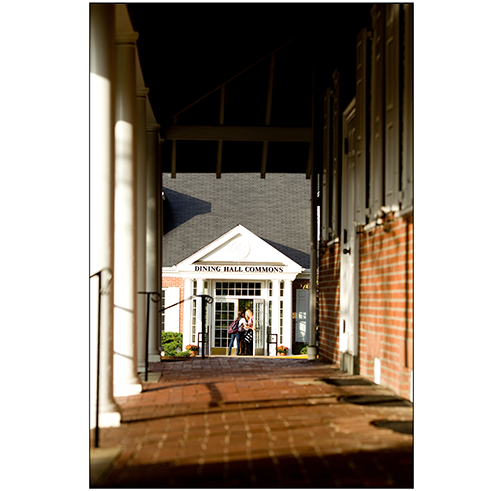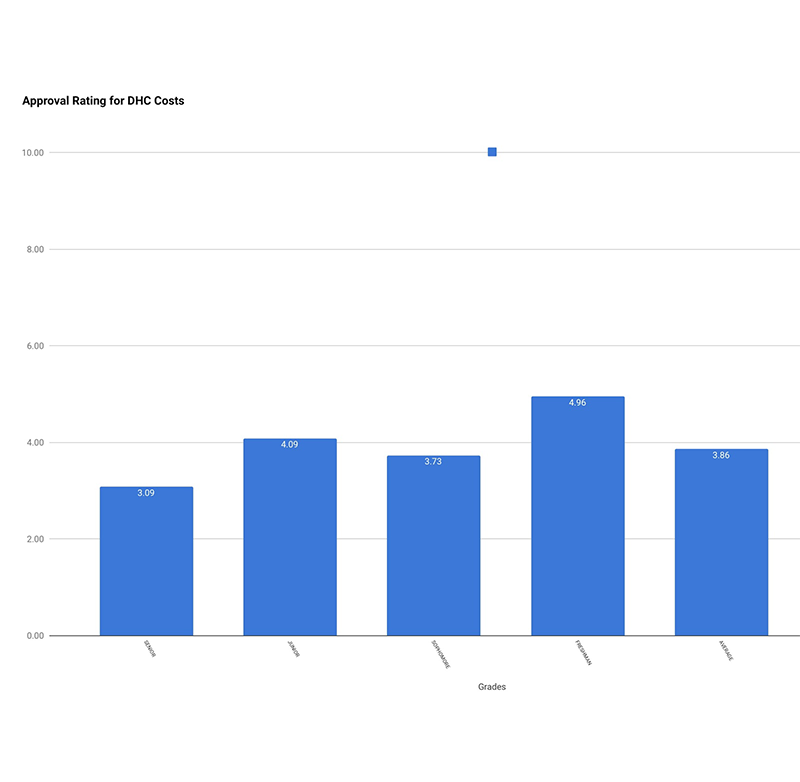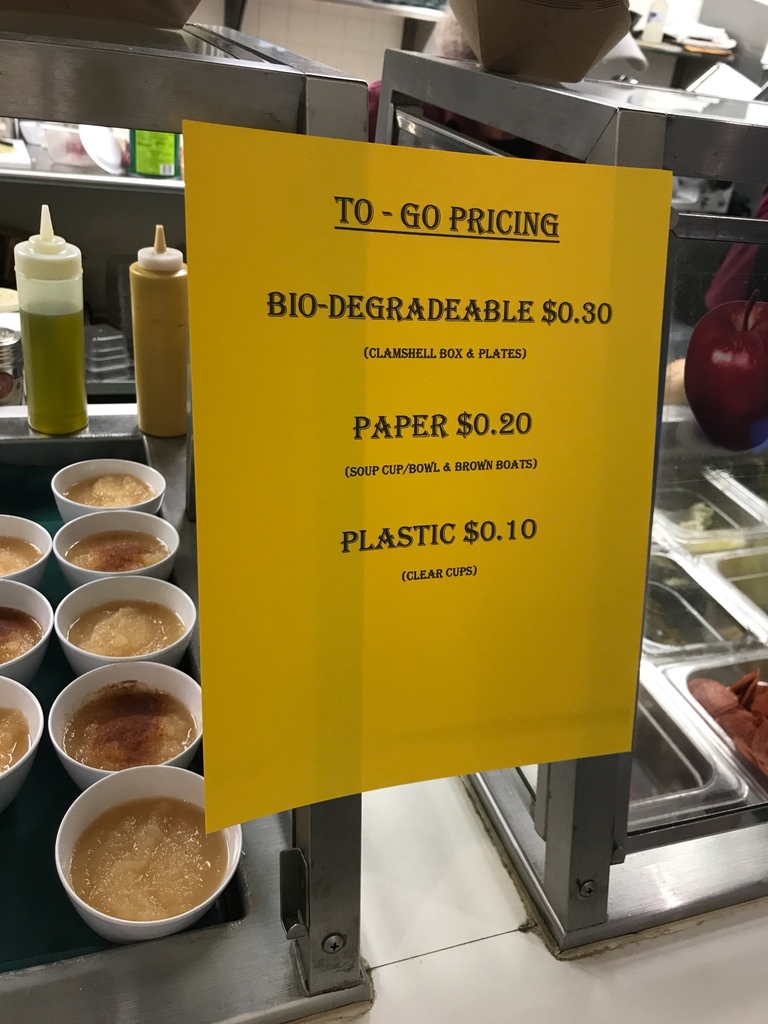Food For Thought: An In-Depth Look at DHC Pricing
By Andrew Rowan, Ali Chesnick, Andrew Shah, Esha Nittoor and Sam Abiola
May 25, 2017
How We Got Here
By Esha Nittoor
In the last few months, Healthy Foods By Choice, the company that manages food service in the Dining Hall Commons, has been a topic of frustration among staff and students. These complaints spanned a vast range of topics from the prices to Barb Caden being fired from the Dining Hall. Many complain that the Dining Hall has an unfair monopoly over the students purchasing lunch. Teachers have noticed an increase in students ordering food for delivery from Main Street during their lunch period.
However, before delving into the issues, it would be wise to first understand the school’s history with Healthy Foods By Choice.
Before Healthy Foods By Choice was implemented in the cafeteria the school had another lunch program. Lisa Carbone Warren called the old lunch system “institutional” and described the food as being “gross, frozen things that [the company] would heat up in the oven.” With the addition of Healthy Foods by Choice, the school was expecting fresh cooked food everyday.
Choice Foods Inc., Healthy Foods by Choice’s parent company, was originally a caterer for the school’s development events. The company didn’t originally have a school lunch program, but the school was eager to try the company out since it was a local business. Because MFS is a small school, finding lunch providers is often hard because companies often need a certain amount of people to purchase food in order to make a profit. One solution many schools use is to provide a mandatory lunch, in which every student must eat in the cafeteria, and students aren’t given the option of bringing lunch or ordering out. The cafeteria at MFS, however, is a retail program. The school pays Choice Foods to manage the DHC. This means, according to Carbone Warren, that Choice Foods doesn’t make a profit off of selling lunch to the students, and the school breaks even with the sales.”We pay them a fee to manage the lunch program,” said Carbone Warren.
When first bringing Healthy Foods By Choice into the cafeteria, the school made sure to sit down with the students and staff in order to get their opinions on the food options. Together, they created a menu with multiple options for the students to choose from. Over the years, the school has looked around for other offers from multiple companies, but has decided to stay with Healthy Foods By Choice, which they have deemed the best option for our school.
Show me the Money (Prices)
By Andrew Shah
In order to better understand student complaints, WordsWorth sent out a poll (via e-mail) that asked the students how favorably they viewed the Dining Hall’s prices and why they ordered out instead of eating food from the Dining Hall. On a scale from zero to ten (zero being very unfavorable and ten being very favorable), the average rating across the four grades was a 3.86 out of 10. We also collected some video of students answering these pressing questions.
“I understand that prices are going to be higher than in other places, however it comes to the point where it is getting harder to buy lunch because it is so expensive.”
Responses like this one could be found from many people. There were also a lot of responses that talked about difference in pricing and food quality between the food from the Dining Hall and food from Main Street.
“The dining hall overcharges for sub par to just par food. Even though I am on contract, the prices for all of the school (including vending machines and the cafeteria store) food that the company provides in relation to the quality of said food often pushes me to go to Main Street instead.”
The direct relationship between food quality and pricing was a common complaint among students, and many said that high Dining Hall prices led them to go to Main Street, but as Director of Finance and Operations Lisa Carbone Warren pointed out, not all meals are equal. In response to a question about difference in prices between the Dining Hall and Main Street, Carbone Warren told WordsWorth that while students may get cheaper food on Main Street, it is not necessarily healthy food.
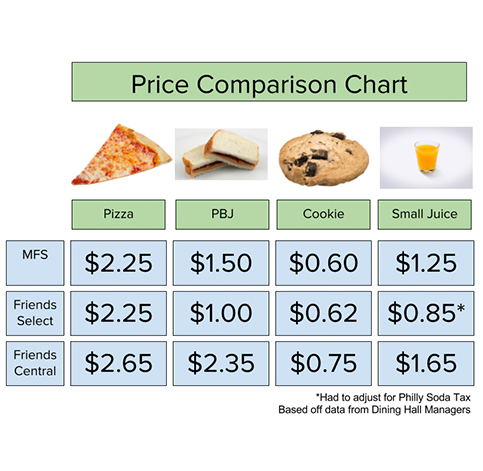
An additional part of WordsWorth’s investigation into the Dining Hall was a look into how much money a complete meal would cost each day. That number turned out to be an average $10 (read more about this in our contract section), which over the course of our 165 day school year would be $1650. That number may seem like a lot, but Lisa Carbone Warren told WordsWorth that the prices are lower than other private schools in the area. As for the prices of specific items in the DHC, they are set by the administration and Healthy Foods by Choice at the beginning of the year. Prices are not changed unless a special circumstance arises. For example, if Healthy Foods by Choice’s letter supplier is having a lettuce shortage, and the company has to pay more for lettuce, there may be a slight increase in price with items that include lettuce. Carbone Warren also told us that prices for the snack foods are higher so that the prices of the healthier options can stay reasonably priced.
An Added Fee to Leave
By Andrew Rowan
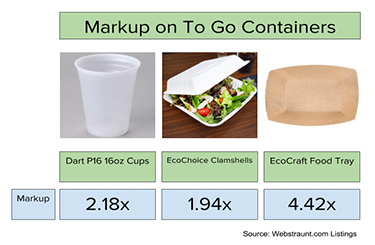
To Go containers are a hot point with students and faculty’s frustration with the Dining Hall Commons. There is an additional charge for taking disposable containers: $0.30 for salad clamshells, $0.20 for hot and sandwich boats, and $0.10 for plastic cups.
“The administration wanted us to have biodegradable and wanted us to reduce our footprint and be environmentally sustainable,” said Director of Finance and Operations Lisa Carbone Warren.
She explained that the administration thought it was much more friendly to use the actual dishes and wash them, rather than use disposable ones. Carbone Warren went on to explain that it’s the students’ choice if they decide to leave the Dining Hall, and they will pay a fee for that.
When pressed about the contradiction between Upper School administration constantly encouraging students to leave the Dining Hall to go to clubs, which would end up costing students more money, Carbone Warren asked for suggestions from the student body for better solutions. She added, “They are expensive, and they are just charging what it costs [Choice Foods] to get them.”
WordsWorth attended the Food Quality Meeting, a group of teachers and students from various divisions in the school who meet with Dining Hall Manager Kimberly Watson and Choice Foods Owner Karen Gosik. The group meets three times each year to discuss various topics regarding the Dining Hall.
When asked about the prices of the to go containers, Choice Foods Owner Karen Gosik said, “Choice Foods is part of a bigger company, and we have deals with other vendors. If we have clients that distribute the same types of biodegradable containers that we use here, we actually get a bulk purchase and that helps [with the price].”
Research from vendors such as Webstaurant Store, who Choice Foods told us is not their vender, has the same to go products listed nearly 2 to 5 times cheaper than the current to go prices. Gosik said that they will do some more research for new vendors and circle back with other options, as the prices for more sustainable materials may have lowered.
Dining Hall patrons may have also noticed a new $0.10 charge for plastic SOLO cups. Carbone Warren was originally unaware of the new charge at our interview, and said that Healthy Foods by Choice was not permitted to introduce new charges during the school year.
Dining Hall Manager Kimberly Watson told attendees when prompted at the Food Quality Meeting, “As far as the paperwork [between the school and Choice Foods], we charge for recyclable and biodegradable [products]. Our cups are recycled SOLO cups. They are real[ly] thin and made out of recycled plastic.”
WordsWorth discovered that the cups in question, Dart SOLO P16 16oz cups are not made out of of recycled plastics. A customer service representative from the Webstaurant Store told us they don’t have the cups “listed as having an[y] environmental benefits.”
The Dart website only lists that the cup is able to be recycled. Watson said that they were told by the company they ordered the cups from that they were recycled plastic. Carbone Warren explained to the Food Quality meeting that there had been some misunderstanding about the charges. The school’s vision was only for biodegradable items, and there would only be a charge for biodegradable items. The cups are not biodegradable, as they are made of plastics. Carbone Warren, Watson, and Gosik said they would meet privately to discuss the matter further. As it stands now, there is still a charge for the cups.
“I think it punishes you for taking part in the community,” said Sophomore Liam Schenk, regarding the to go prices.
On a WordsWorth survey, one Junior commented, “I think it's ridiculous that the Dining Hall charges extra for paper plates when students are encouraged by the school to attend meetings, clubs, etc. during the lunch block, yet can't take regular plates out of the Dining Hall. The fact that they have started charging extra for cups is beyond ridiculous.”
A Sophomore added, “don’t charge me for to-go containers!”
How Can Consumers Save Money?
By Sam Abiola
Contract is a flat free that the students pay for lunch during the entire school year. Students who are on contract are entitled to one hot entree, two hot sides or one hot side with a small plain salad, dessert and milk or juice to drink. The average cost of a full contract meal per day is approximately $10:33. The average cost of a full contract meal plan per school year is $1,225.00. The potential lunch cost per school year of a student who is not on contract is $1,705.00. This means that a student can save approximately $480.00 per year by being on a lunch contract.
People Are Going Elsewhere
By Ali Chesnick
Ordering food from Main Street has become an increasingly popular food option for students. Though only seniors and, at a certain point, juniors can use their privileges to go “uptown” for lunch or on free periods, many underclassmen have found a way around that by using their cellphones to order food from Main Street restaurants. This has become more prevalent during the 2016-17 school year and has even come up as a topic in faculty meetings. In a WordsWorth survey, students were asked why they choose to order food from Main Street for lunch. 76% of students listed a better price as a reason for ordering out and 90% said that they order in due to the better quality of food.
In response to these statistics, Lisa Carbone Warren said that comparing Main Street and the DHC is like comparing apples and oranges. She explained that though the DHC might be more expensive, it is healthier when compared to meals that students will order from Main Street, making the DHC worth the higher price.
Conclusion
During this investigation, our team was able to learn a lot about the how the Dining Hall operates. We were able to take a look into the specifics of food pricing, To-Go pricing, Contract pricing, and why students are ordering out. We found that the students and faculty were generally satisfied with the quality of the food. The level of frustration came from the prices of the food and the misunderstanding of how they are created. Lisa Carbone Warren said she would work with the Dining Hall to clarify some of the confusion for the students. We hope this article provides the MFS Community with some insight on why the Dining Hall prices are the way that they are.
Web Layout: Chloe Jones

